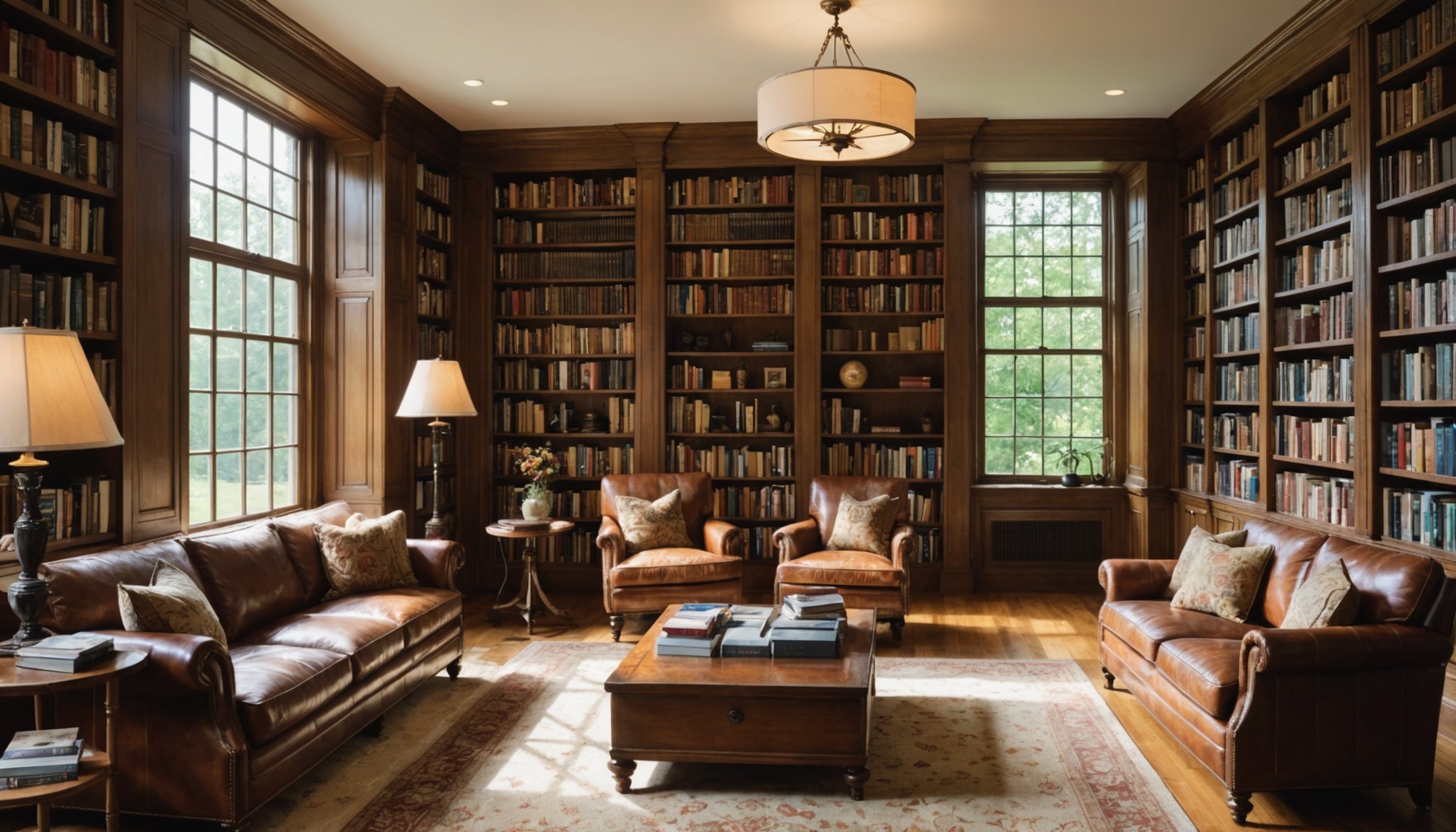The Importance of Natural Light in Home Libraries
Natural light plays a pivotal role in enhancing both productivity and mood within a home library. Studies consistently highlight the benefits of natural light exposure on cognitive functions, showing improvements in focus and work efficiency. When a library is bathed in natural light, there is often a noticeable boost in mood and overall well-being, creating an ideal environment for concentration and study.
Moreover, natural light contributes to a healthier indoor environment. It reduces reliance on artificial lighting, which not only saves energy but also avoids the negative effects of excessive artificial light exposure. Integrating natural light effectively within home libraries can result in spaces that are both functional and welcoming.
In parallel : Designing your serene screen-free family retreat: a comprehensive guide for modern homes in the digital age
Increasing exposure to natural light also supports the body’s natural circadian rhythms, aiding in improved sleep quality and mental sharpness. For those interested in creating an optimal home library environment, considering how to maximise natural light should be a priority.
In essence, the benefits of natural light in home libraries are substantial, influencing not only architectural aesthetics but also significantly impacting productivity and enhancing mood.
Additional reading : Transform your humid bathroom: a comprehensive guide to installing vertical moss walls
Design Tips for a Bright Home Library
Incorporating strategic design can significantly amplify the presence of natural light in your home library. Utilising light colours in both paint and décor is essential to reflect and enhance this illumination naturally. These colours not only brighten the space visually but also add a welcoming and airy atmosphere, essential for invigorating your reading environment.
The choice of furniture plays a pivotal role in this design strategy. Opt for pieces that align with a lighter, airy theme. Lighter wood finishes, glass elements, and minimalist designs can complement the overall aesthetic of a bright home library, ensuring they do not hinder the flow of light.
Strategic layout of the library further maximises light exposure. Consider arranging furniture and bookshelves where they do not obstruct the windows or doors, allowing for an optimal light flow throughout the day. Prioritising natural light exposure in the design phase ensures your home library remains a sanctuary of warmth and illumination, ideal for both productivity and relaxation. Through thoughtful design choices, you can successfully create a bright, inviting home library that merges functionality with aesthetics.
Lighting Solutions to Enhance Natural Light
When considering lighting solutions for enhancing natural light in a home library, the focus is on balancing natural and artificial light to create a harmonious ambiance.
Selecting the Right Light Fixtures
Light fixtures should complement natural light rather than overpower it. Opt for fixtures with adjustable settings or dimmers to replicate natural light at different times of the day. Fixtures incorporating LED bulbs are energy-efficient and mimic daylight efficiently, helping maintain the natural light ambiance.
Incorporating Smart Lighting
Incorporating smart lighting solutions offers homeowners flexibility and control. This technology allows adjustment of light intensity and colour temperature throughout the day, promoting a consistent ambiance that aligns with the body’s circadian rhythms.
Layering Light Sources for Depth
To create depth and reduce harsh shadows, layer various types of lighting. A combination of task lighting for reading, ambient lighting for overall illumination, and accent lighting to highlight key areas can transform a library into a dynamic, well-lit space. Each light source should be strategically placed to complement the natural light flow, ensuring a cohesive and inviting atmosphere.
Furniture Recommendations for Optimal Light Utilization
Selecting the right furniture enhances light utilization and contributes to an inviting home library atmosphere. Begin with pieces that complement daylight, allowing it to flow freely. Opt for furniture with light finishes and materials such as glass or light wood to reflect and distribute natural light effectively.
Multi-functional furniture can serve various roles, maximizing space and adaptability. For example, consider bookshelves with an open back design, which enables light to pass through and maintains an airy feel. Adjustable furniture, like height-modifiable desks or foldable tables, provides flexibility to arrange the space without obstructing natural light.
Efficient space management is crucial for ensuring optimal light flow. Position seating near windows to take advantage of daylight. Arrange bookshelves perpendicular to walls with windows to avoid blocking light pathways. By carefully considering furniture placement, you maintain an open and bright environment conducive to both productivity and relaxation.
Incorporating these strategies not only enhances natural light but also adds to the overall aesthetic and functionality of your home library.
Layout Strategies for a Well-Lit Home Library
Achieving an optimal room layout in a home library can significantly improve light flow while enhancing the space’s functionality. Strategic placement of windows and doors is crucial. Arrange windows to face the direction of most sunlight exposure during the day, boosting natural illumination. Glass doors or large windows on opposite walls can create a cross-light pattern, maximizing brightness.
An open-concept design encourages light to permeate more freely, compared to confined, closed spaces. Merging spaces without partition walls can create a unified area basking in natural light, ideal for reading. For those who prefer defined spaces, using translucent partitions instead of solid ones can allow light to penetrate while maintaining distinct zones.
Create specific zones to leverage varying light levels. For tasks requiring focus, position reading nooks near windows. Shelving can frame the outer walls, leaving central spaces open for natural light to flow. This thoughtful space configuration results in a harmonious balance, ensuring every corner benefits from available light, making the library conducive to both focus and relaxation.
Examples of Well-Lit Home Libraries
Examining case studies of well-lit home libraries provides valuable insights into achieving optimal light flow and aesthetics. These examples encompass diverse architectural styles, showcasing how different design elements can be harmoniously integrated to maximise natural light. A key feature of successful designs is the strategic use of large window panels and skylights. Such elements leverage abundant daylight, creating spaces that are both inviting and functional.
One notable case involves a library that incorporates a high ceiling with clerestory windows, allowing light to cascade throughout the room. This creates an environment where even peripheral spaces benefit from natural illumination. Another exemplary design employs mirrors and reflective surfaces to amplify light, enhancing both brightness and atmosphere.
These libraries exemplify the importance of cohesive design elements like light-coloured walls and airy furnishings, which contribute significantly to the space’s overall ambiance. By understanding these design concepts, individuals can draw inspiration and craft their own well-lit home libraries that prioritise both form and function. Each design serves as a testament to the transformative power of natural light in home settings.
Actionable Steps to Incorporate Natural Light
Enhancing natural light in your home library can be achieved through thoughtful home improvement strategies. Begin by exploring architectural changes like adding or expanding windows, skylights, or light wells. Skylights, in particular, can dramatically increase daylight exposure by harnessing overhead light, making them an ideal solution for enhancing vertical light entry.
For those seeking to maximise light without major construction, consider cost-effective ways to adjust existing spaces. Removing heavy drapery, opting for sheer curtains, or installing frosted glass can significantly brighten your library while maintaining comfort and privacy. Mirrors strategically placed can also help bounce light across the room, creating an illusion of additional light sources.
Privacy is important; thus, incorporating frosted window films or adjustable blinds allows for maintaining privacy without compromising on natural light. Another option includes installing reflective surfaces along key walls to amplify light flow.
By understanding and implementing these steps, you can transform your library into a well-lit, inviting sanctuary where productivity and mood are elevated through the strategic enhancement of natural light.

